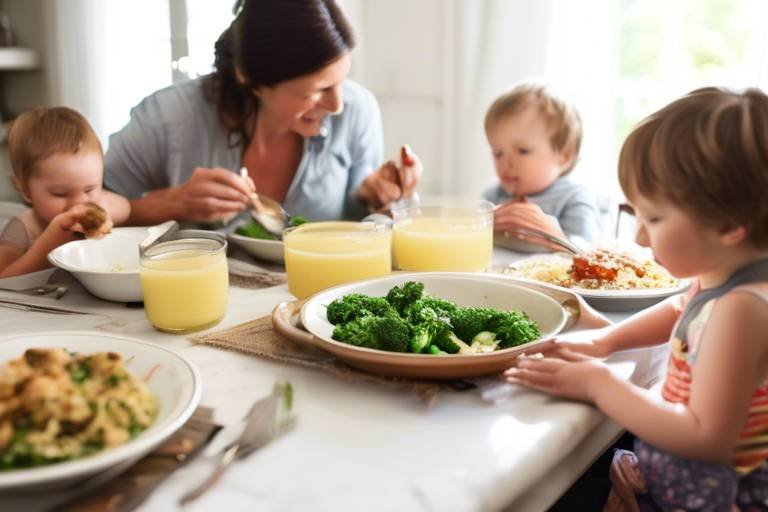Tips for Nourishing Your Family with Home-Cooked Meals
In today’s fast-paced world, it can be all too easy to rely on takeout and processed foods. However, nothing beats the warmth and comfort of home-cooked meals. Not only do they provide a fantastic opportunity to bond with your loved ones, but they also allow you to control the ingredients, ensuring that your family receives the nutritional benefits they need. Imagine the aroma of freshly baked bread wafting through the house or the cheerful chatter around the dinner table as everyone digs into a delicious meal made with love. This article provides practical advice and creative ideas for preparing healthy, home-cooked meals that cater to your family's tastes and nutritional needs, fostering a love for cooking and eating together.
Every family member has unique nutritional requirements based on their age, activity level, and health conditions. For instance, children need a diet rich in calcium and vitamins to support their growth, while adults may require more protein and fiber to maintain their energy levels. Understanding these needs is the first step towards crafting meals that not only satisfy hunger but also promote overall health. Consider consulting with a nutritionist or using online resources to assess your family's specific dietary requirements. By incorporating a variety of food groups—such as fruits, vegetables, whole grains, proteins, and healthy fats—you can create balanced meals that cater to everyone’s needs.
Effective meal planning can save time and reduce stress in the kitchen. Think of it as creating a roadmap for your week. Start by jotting down your family's favorite meals and any new recipes you’d like to try. Planning a weekly menu not only aligns with your family's preferences but also ensures you have healthy options on hand. You can even involve your family in the planning process—ask for their input on what they’d like to eat! This can make everyone feel included and excited about the meals to come.
A well-organized grocery list is essential for successful meal preparation. Once you have your meal plan, create a list that categorizes items by sections of the store—produce, dairy, meats, and pantry staples. This approach minimizes waste and maximizes nutrition based on your meal plan. Plus, it helps you avoid those tempting impulse buys that can derail your healthy eating goals. Remember, sticking to your list is key!
Using seasonal produce not only enhances flavor but also supports local farmers. When fruits and vegetables are in season, they are often more affordable and packed with nutrients. For example, summer brings a bounty of tomatoes and zucchini, while fall is perfect for squash and apples. By incorporating these seasonal ingredients into your meals, you can create vibrant dishes that celebrate the flavors of each season. Think of a warm autumn soup filled with roasted butternut squash and fresh herbs—it’s a comforting dish that’s both nourishing and delicious!
Eating healthy doesn't have to break the bank. Here are a few practical tips for shopping smartly:
- Use coupons and look for sales on healthy items.
- Buy in bulk for pantry staples like rice and beans.
- Plan your meals around sales and seasonal produce.
By being strategic with your grocery shopping, you can make the most of your budget while still providing your family with nutritious meals.
Batch cooking is a time-saving technique that allows you to prepare meals in advance. Imagine spending a few hours on the weekend to cook large portions of your favorite dishes, then freezing them for later. This not only saves time during busy weeknights but also ensures you always have a healthy meal on hand. When freezing meals, be sure to use airtight containers or freezer bags to prevent freezer burn. Label each container with the date and contents for easy identification later on.
Engaging family members in the cooking process can enhance their appreciation for home-cooked meals. It’s not just about preparing food; it’s about creating memories together. Get everyone involved, from meal prep to cooking and cleanup. You could assign age-appropriate tasks, like chopping vegetables or stirring sauces, making it a fun family activity. Plus, cooking together can spark conversations and laughter, turning meal prep into a cherished family time.
Cooking with children can be a fun and educational experience. Kids love to help in the kitchen, and involving them in cooking can teach them valuable skills. Start with simple recipes that allow them to participate, such as making homemade pizza or baking cookies. Assign tasks like measuring ingredients or mixing batter. Not only does this make cooking more enjoyable, but it also helps them develop a love for healthy foods and cooking.
Establishing cooking traditions can strengthen family bonds. Whether it’s a weekly taco night or a monthly baking day, having set times to cook together creates lasting memories. These traditions can be passed down through generations, fostering a sense of belonging and togetherness. Think of it as creating a family cookbook filled with recipes and stories that can be cherished for years to come.
Q: How can I get my family to eat healthier?
A: Start by incorporating more fruits and vegetables into meals, and involve your family in meal planning and preparation. Making cooking fun can also encourage healthier eating habits.
Q: What are some quick meal ideas for busy nights?
A: Consider simple stir-fries, pasta dishes, or sheet pan meals that can be prepared in under 30 minutes. Meal prepping on weekends can also save time during the week.
Q: How can I make cooking more enjoyable for my kids?
A: Choose fun recipes that allow for creativity, like decorating cookies or assembling their own tacos. Make it a game or a challenge to keep them engaged.

Understanding Nutritional Needs
Every family member has unique nutritional requirements, and understanding these needs is crucial for crafting meals that nourish both body and soul. Think of your family's health as a puzzle; each piece represents different dietary needs based on age, gender, activity level, and health conditions. For instance, children require more calcium for growing bones, while adults may need higher fiber to support digestion. It's essential to assess these needs and create a balanced approach to mealtime.
To start, consider conducting a quick assessment of your family's dietary habits. This can be as simple as jotting down what everyone typically eats in a week and noting any gaps or areas for improvement. Once you have a clearer picture, you can incorporate a variety of food groups into your meals. A well-rounded plate should include:
- Fruits and Vegetables: Aim for a rainbow of colors to ensure a wide range of vitamins and minerals.
- Whole Grains: Opt for brown rice, quinoa, and whole-grain bread to boost fiber intake.
- Proteins: Include lean meats, beans, and legumes to support muscle health.
- Dairy or Alternatives: Choose low-fat options or fortified plant-based alternatives for calcium.
Additionally, it's helpful to be aware of any food allergies or intolerances within your family. This knowledge allows you to tailor meals that are not only nutritious but also safe for everyone. For example, if someone is lactose intolerant, you can explore alternatives like almond milk or lactose-free yogurt. It’s all about making informed choices that cater to everyone’s needs.
Another vital aspect of understanding nutritional needs is recognizing the importance of portion sizes. Serving appropriate amounts can help prevent overeating and ensure everyone gets the nutrients they require. A great way to visualize portion sizes is by using the MyPlate method, which divides your plate into four sections: fruits, vegetables, grains, and proteins, with a side of dairy. This method not only simplifies meal prep but also encourages a balanced diet.
Finally, don't forget to involve your family in discussions about nutrition. Teaching kids about healthy eating can empower them to make better choices as they grow. Consider having family meetings where you discuss meal ideas, nutritional goals, and even cooking together. This collaborative approach fosters a love for cooking and eating well, creating lasting habits that benefit everyone.

Meal Planning Strategies
Meal planning is like a treasure map for your kitchen adventures! It can save you time, reduce stress, and help you whip up delicious meals that everyone in your family will love. Imagine walking into your kitchen with a clear plan instead of feeling like you're on a scavenger hunt for ingredients. Sounds great, right? So, how do you get started on this culinary journey?
First, it’s essential to consider your family's preferences and dietary needs. Do you have picky eaters at home? Or maybe someone with food allergies? Understanding these factors will help you craft a weekly menu that not only satisfies everyone but also keeps things nutritious. A well-thought-out meal plan allows you to include a variety of food groups, ensuring balanced nutrition. Think of it as building a colorful plate that represents all the food groups!
Next up is the art of creating a grocery list! This isn’t just any list; it’s your shopping companion that minimizes waste and maximizes nutrition. Once you’ve mapped out your meals for the week, jot down all the ingredients you need. This will not only help you stay organized, but it will also prevent those last-minute trips to the store for forgotten items. You can even categorize your list by sections of the grocery store, such as produce, dairy, and grains, to make your shopping trip smoother. Here’s a quick table to illustrate how you might organize your grocery list:
| Category | Items |
|---|---|
| Fruits & Vegetables | Carrots, Spinach, Apples, Bananas |
| Dairy | Milk, Yogurt, Cheese |
| Proteins | Chicken, Tofu, Eggs |
| Grains | Rice, Quinoa, Whole Wheat Bread |
Another fantastic strategy is to incorporate seasonal ingredients into your meals. Not only do seasonal foods taste better, but they are often more affordable and packed with nutrients. Plus, you’ll be supporting local farmers! Imagine biting into a ripe, juicy tomato in the summer or savoring hearty squash in the fall. By planning your meals around what's in season, you can create dishes that are bursting with flavor.
And let’s not forget about budget-friendly shopping tips! Eating healthy on a budget is possible with a little creativity. Look for sales, use coupons, and consider shopping at local farmers' markets. You can also buy in bulk for items that you use frequently, which can save you money in the long run. Remember, healthy eating doesn’t have to be expensive; it just requires a little planning and resourcefulness.
Lastly, batch cooking is a game-changer when it comes to meal planning. This technique allows you to prepare larger quantities of meals in advance, which you can then freeze for later use. Think of it as a cooking marathon where you whip up a week’s worth of meals in one go! Not only does this save time during busy weekdays, but it also means you’ll always have a healthy option on hand. Just imagine opening your freezer to find a delicious homemade lasagna ready to heat up after a long day!
Meal planning is all about making your life easier while ensuring your family enjoys nutritious and delicious meals. By understanding your family’s needs, creating a solid grocery list, incorporating seasonal ingredients, shopping smartly, and utilizing batch cooking, you can transform your kitchen into a hub of healthy eating and joyful family meals.
- How do I start meal planning? Begin by assessing your family's dietary needs and preferences, then create a weekly menu and grocery list based on those meals.
- What if my family has different dietary restrictions? You can plan meals that have interchangeable ingredients, allowing you to cater to everyone's needs without cooking separate meals.
- How can I make meal prep fun for my family? Involve your family members in the cooking process by assigning age-appropriate tasks and making it a fun bonding experience.

Creating a Grocery List
Creating a grocery list might seem like a mundane task, but it's actually a powerful tool that can transform your cooking experience. Imagine walking into a grocery store with a clear plan in mind, confidently navigating the aisles instead of wandering aimlessly. A well-organized grocery list not only saves you time but also helps you stick to your budget and reduce food waste. So, how do you craft the perfect grocery list?
First, start by reviewing your meal plan for the week. Take a moment to jot down all the ingredients you'll need for each meal. This is where having a structured plan pays off big time. You might want to categorize your list into sections based on the layout of your grocery store. For example, you can create sections for:
- Fruits and Vegetables
- Dairy Products
- Meat and Seafood
- Grains and Pasta
- Canned and Dry Goods
- Snacks and Beverages
By grouping items, you'll make your shopping trip more efficient. Plus, it prevents you from forgetting essential ingredients that could derail your meal prep. Another tip? Keep your grocery list handy on your phone or use a note-taking app. This way, you can easily update it as you run out of items throughout the week. Imagine you're whipping up a delicious pasta dish and realize you're out of olive oil. With a digital list, you can quickly add it while you're still in the kitchen.
Now, let’s talk about minimizing waste. When creating your grocery list, consider the quantity of each item you need. It's easy to overestimate how much produce you’ll consume, leading to spoiled food. A practical approach is to check your pantry and fridge before you shop. This ensures you only buy what you need and helps you utilize ingredients you already have. For instance, if you have half a bag of quinoa left, you might want to plan a dish that incorporates it, rather than buying a new bag.
Lastly, don’t forget to include snacks and treats! While it’s essential to focus on healthy options, it’s also important to indulge in a little fun. After all, cooking should be an enjoyable experience for the whole family. Consider involving your kids in this process—they can help choose their favorite snacks or even suggest a fun meal idea, making them feel more invested in what’s being cooked.
In summary, creating a grocery list is an art that combines planning, organization, and a bit of creativity. By being intentional about what you buy, you not only enhance your cooking experience but also foster a healthier lifestyle for your family. So grab that notepad, or fire up your favorite app, and start crafting your grocery list today!
Q: How often should I update my grocery list?
A: It's a good idea to update your grocery list weekly, ideally before you plan your meals for the upcoming week. This helps you keep track of what you need and reduces the chances of impulse buying.
Q: What if I forget to add something to my list?
A: No worries! If you realize you've forgotten an item while shopping, just add it to your list for next time. Alternatively, you can quickly check if you can substitute it with something else you already have at home.
Q: Can I use my grocery list for meal prep?
A: Absolutely! Your grocery list is a great companion to your meal prep plan. By aligning your list with your prep schedule, you can ensure you have all the ingredients ready to go when it's time to cook.

Incorporating Seasonal Ingredients
When it comes to cooking for your family, one of the most delightful ways to elevate your meals is by incorporating seasonal ingredients. Not only do these ingredients burst with flavor, but they also provide a nutritional punch that can enhance your family's health. Imagine biting into a juicy, sun-ripened tomato in the summer or savoring the warmth of roasted squash in the fall—these are the experiences that seasonal cooking can bring to your table.
But how do you know which ingredients are in season? A great starting point is to familiarize yourself with the seasonal produce in your region. For instance, in the spring, you might find asparagus, strawberries, and peas making their grand debut, while the fall welcomes pumpkins, apples, and brussels sprouts. Utilizing a seasonal calendar can be incredibly helpful. Here’s a simple table to illustrate:
| Season | Fruits | Vegetables |
|---|---|---|
| Spring | Strawberries, Rhubarb | Asparagus, Spinach, Peas |
| Summer | Watermelon, Berries | Tomatoes, Zucchini, Corn |
| Fall | Apples, Pears | Pumpkin, Squash, Kale |
| Winter | Citrus Fruits, Pomegranates | Root Vegetables, Cabbage |
Using seasonal ingredients not only supports your local farmers but also reduces your carbon footprint—after all, local produce doesn’t need to travel far to reach your plate. This can make a significant difference in the freshness and taste of your meals. Plus, seasonal cooking can inspire creativity in the kitchen. Why not try a new recipe that highlights that beautiful winter squash or those vibrant summer tomatoes? The options are endless!
Another great benefit of cooking with seasonal ingredients is the potential for cost savings. When fruits and vegetables are in season, they are often more abundant and, consequently, less expensive. This means you can enjoy high-quality, fresh produce without straining your budget. So, the next time you're at the grocery store or local farmers' market, take a moment to explore what's in season—your taste buds and your wallet will thank you!
Incorporating seasonal ingredients into your family meals can also be a fun way to teach kids about food and where it comes from. You can involve them in selecting ingredients at the market, discussing the importance of eating fresh produce, and even growing a small herb garden at home. By making it a family affair, you're not just nourishing their bodies but also fostering a love for cooking and healthy eating that can last a lifetime.

Budget-Friendly Shopping Tips
Eating healthy on a budget is not just a dream; it can be your reality with a bit of planning and creativity. First and foremost, set a budget for your grocery shopping. Knowing exactly how much you can spend will help you make informed choices and avoid impulse buys. Once you’ve established your budget, it’s time to put on your thinking cap and strategize!
One effective way to save money is to take advantage of store sales and coupons. Many grocery stores offer weekly specials, and using coupons can significantly reduce your expenses. Websites and apps dedicated to couponing can help you find the best deals. Combine these with your meal plan to maximize savings. For example, if chicken is on sale, consider planning a few meals around it for the week.
Another tip is to buy in bulk when possible. Items like rice, beans, and pasta can often be purchased in larger quantities at a lower price per serving. Just make sure you have the storage space for these bulk items! Additionally, consider shopping at local farmers' markets. Not only can you find fresh produce at lower prices, but you also support local farmers and get to enjoy seasonal fruits and vegetables.
When it comes to produce, remember that frozen fruits and vegetables can be just as nutritious as fresh ones and are often less expensive. They last longer, too, which means less waste. In fact, many frozen options are picked at peak ripeness and flash-frozen, locking in their nutrients. So, don’t hesitate to stock up on these handy items!
Lastly, it’s crucial to plan your meals around what's on sale and what you already have in your pantry. This not only helps you save money but also reduces food waste. Check your pantry and fridge before you head out shopping. Create a list based on what you need and stick to it. Allowing yourself to stray from the list can lead to unnecessary purchases.
With these budget-friendly shopping tips, you can nourish your family with delicious, healthy meals without breaking the bank. Remember, it’s all about being smart with your choices and planning ahead!
- How can I eat healthy on a tight budget? Planning meals, using coupons, buying in bulk, and choosing seasonal produce can help you maintain a healthy diet without overspending.
- Are frozen fruits and vegetables as healthy as fresh? Yes! Frozen produce is often picked at peak ripeness and can be just as nutritious as fresh options.
- What are some good bulk items to buy? Staples like rice, beans, pasta, and oats are excellent choices for bulk purchases.
- How can I minimize food waste? Planning meals based on what you already have and buying only what you need can significantly reduce food waste.

Batch Cooking and Freezing
Batch cooking is like hitting the culinary jackpot! Imagine preparing a feast all at once and having delicious meals ready to go throughout the week. This time-saving technique not only simplifies your dinner routine but also helps reduce food waste and save money. When you batch cook, you can make larger portions of your favorite dishes, allowing you to freeze leftovers for later enjoyment. It's a win-win situation that brings convenience and flavor to your family's table!
To get started with batch cooking, begin by selecting a few recipes that your family loves. Think about meals that freeze well, such as soups, stews, casseroles, and even some pasta dishes. Once you have your recipes in mind, set aside a few hours on the weekend or a day off to cook. This dedicated time will pay off as you stock your freezer with wholesome meals.
When preparing your meals, consider using quality storage containers that are freezer-safe. Glass containers are great for reheating, while sturdy plastic ones can save space. Make sure to label each container with the name of the dish and the date it was cooked. This little step will save you from the dreaded mystery meal later on!
After cooking, let the meals cool down before placing them in the freezer. This prevents condensation and ice crystals from forming, which can affect the texture and flavor of your food. When you're ready to enjoy a meal, simply take it out of the freezer and let it thaw in the refrigerator overnight. You can then reheat it on the stove or in the microwave, and voilà! A home-cooked meal is ready in no time.
Additionally, batch cooking isn't just about preparing individual meals. You can also cook large quantities of ingredients, such as grains, beans, or roasted vegetables, to use throughout the week. For example, if you roast a big batch of sweet potatoes, you can use them in salads, tacos, or as a side dish. This versatility makes meal prep even easier.
Here's a quick table to help you visualize the benefits of batch cooking:
| Benefits of Batch Cooking | Details |
|---|---|
| Saves Time | Prepare multiple meals in one go, freeing up your week. |
| Reduces Food Waste | Utilize ingredients fully and minimize leftovers that go bad. |
| Cost-Effective | Buy in bulk and save on grocery bills while eating healthier. |
| Promotes Healthy Eating | Control ingredients and portions to suit your family's needs. |
Incorporating batch cooking into your routine can transform your approach to meal preparation. You’ll find that it not only makes cooking less of a chore but also brings your family together around the dinner table more often. So why not give it a try? You might just discover a new family tradition in the process!
Q: How long can I keep frozen meals?
A: Most frozen meals can last up to three months in the freezer without losing quality. However, for best taste, aim to consume them within one to two months.
Q: Can I freeze any type of food?
A: While many foods freeze well, some items, like raw vegetables, may need blanching first. Additionally, foods with high water content, like lettuce, may not freeze well.
Q: How do I reheat frozen meals safely?
A: The best way to reheat frozen meals is to thaw them in the refrigerator overnight and then heat them on the stove or in the microwave until they reach an internal temperature of 165°F (74°C).

Involving Family in Cooking
Cooking together as a family can transform mealtime from a simple task into a cherished bonding experience. Imagine the aroma of freshly baked cookies wafting through the house, laughter filling the air as everyone pitches in. When you involve your family in cooking, you not only create delicious meals but also lasting memories. So, how can you make cooking a fun and inclusive activity for everyone? Here are some creative ideas to get started!
First, consider assigning roles based on age and skill level. For instance, younger kids can help with washing vegetables or stirring ingredients, while older children can take on more complex tasks like chopping or measuring. This not only teaches them valuable life skills but also instills a sense of responsibility. You might find that your little ones are more excited about eating their greens when they’ve had a hand in preparing them!
To make cooking even more engaging, why not turn it into a themed night? You could explore different cuisines from around the world! One week could be Italian night with homemade pizza, while the next could be Taco Tuesday. This not only broadens everyone’s culinary horizons but also makes the cooking process feel like an adventure. Plus, it opens up discussions about different cultures and traditions, enriching your family’s understanding of the world.
Another fantastic way to involve your family is by creating a weekly cooking challenge. Each member can take turns picking a recipe they want to try, and then you can all work together to make it happen. This not only encourages creativity but also helps picky eaters discover new foods they might enjoy. Who knows? Your child may surprise you by loving a dish they initially turned their nose up at!
Don't forget about the importance of cleanup, either. Make it a family affair! Assign everyone a specific task, whether it’s washing dishes, wiping down surfaces, or putting away leftovers. This not only teaches teamwork but also reinforces the idea that cooking is a shared responsibility. You can even turn cleanup into a game, like who can put away the most items in one minute. It adds an element of fun and makes the chore feel less daunting.
Lastly, consider starting a family cooking tradition. Maybe it’s a Sunday brunch where everyone contributes a dish, or a monthly bake-off where you try new recipes. These traditions can foster a love for cooking that extends beyond just meal prep; they can become cherished rituals that your family looks forward to. As you create these traditions, you’ll find that cooking together becomes a source of joy and connection in your home.
Q: What age is appropriate for kids to start cooking?
A: Kids can start helping in the kitchen as early as 2-3 years old with simple tasks like washing vegetables or stirring. As they grow older, you can introduce more complex tasks based on their comfort and skills.
Q: How can I keep my kids engaged during cooking?
A: Try to make cooking fun by incorporating games, themed nights, or cooking challenges. Allow them to choose recipes and give them responsibilities that match their age and abilities.
Q: What if my family is picky about food?
A: Involve them in the meal planning and cooking process. Encourage them to choose recipes they want to try, and be open to experimenting with new ingredients and flavors together.

Cooking with Kids
Cooking with kids can be one of the most rewarding experiences for both parents and children. Not only does it provide a fantastic opportunity to bond, but it also helps children develop essential life skills. Imagine your little one, apron on, standing beside you, eager to mix, stir, and learn. It's a scene that creates lasting memories and fosters a love for food that can last a lifetime. But how do you make this experience enjoyable and safe? Let's dive into some fun ways to get your kids involved in the kitchen!
First off, it's important to choose age-appropriate tasks. For younger children, simple tasks like washing vegetables or stirring ingredients can be exciting and engaging. As they grow older, you can introduce more complex activities such as chopping (with supervision, of course) or measuring ingredients. This gradual increase in responsibility not only builds their confidence but also teaches them the importance of teamwork in the kitchen.
Here are a few fun cooking ideas that you can try with your kids:
- Pizza Night: Let your kids create their own pizzas. Provide a variety of toppings and let them unleash their creativity. It’s a delicious way to teach them about portion control and food combinations.
- Baking Cookies: Baking is a fantastic way to teach kids about measurements and timing. Plus, who doesn’t love the smell of fresh cookies wafting through the house? Make it even more fun by allowing them to decorate their cookies with icing and sprinkles.
- Fruit Salad Party: Have a fruit salad day where kids can choose their favorite fruits to chop and mix. This not only encourages healthy eating but also allows them to explore different flavors and textures.
Moreover, cooking together can also be a great educational opportunity. You can turn it into a science lesson by discussing how different ingredients interact with each other. For example, explain how baking soda makes cookies rise or how heat transforms raw vegetables into delicious cooked ones. This adds an element of learning that can make cooking even more interesting for them.
Don’t forget to make it fun! Play some music in the background, dance around the kitchen, and make silly jokes while you cook. The more enjoyable the experience, the more likely your kids will want to join you in the kitchen again. This positive reinforcement is key to developing their love for cooking.
Lastly, remember that cooking with kids can get messy. Embrace it! The kitchen is a place for creativity and exploration, and a little flour on the floor is a small price to pay for the joy and laughter shared. After all, the memories made in the kitchen are often the ones we cherish the most.
Q: What age is appropriate to start cooking with my child?
A: You can start involving your child in the kitchen as early as 2-3 years old with simple tasks like washing fruits and vegetables. As they grow older, you can introduce more complex tasks.
Q: How do I keep my child safe while cooking?
A: Always supervise your child, especially when using sharp knives or hot surfaces. Teach them about kitchen safety, such as how to handle utensils properly and the importance of washing hands.
Q: What are some easy recipes to start with?
A: Some easy recipes include no-bake desserts, smoothies, and simple pasta dishes. These recipes allow kids to be hands-on without the risks associated with cooking on a stove.

Encouraging Family Traditions
Family traditions can be the glue that holds us together, creating lasting memories that warm our hearts and fill our homes with laughter. One of the most delightful ways to foster these traditions is through cooking. Imagine the aroma of freshly baked cookies wafting through the house on a Sunday afternoon, or the excitement of gathering around the table for a family taco night every Friday. These rituals not only make mealtime special but also provide a wonderful opportunity for bonding and sharing stories.
To cultivate these cherished traditions, start by involving everyone in the decision-making process. Ask your family members what their favorite meals are or if there are specific recipes they associate with special occasions. This engagement not only makes them feel valued but also encourages a sense of ownership over the family's culinary adventures. For instance, you could have a monthly themed dinner night where each family member takes turns choosing the theme, be it Italian, Mexican, or even a "breakfast for dinner" night!
Another fantastic idea is to establish a family recipe book. This can be a fun project where everyone contributes their favorite recipes, along with personal anecdotes or memories associated with each dish. You might even consider digitizing this book to ensure it can be easily updated and shared with future generations. Think of it as a culinary time capsule that captures the essence of your family's journey through food.
Don't forget about the power of storytelling during cooking sessions. As you chop vegetables or stir sauces, share stories from your childhood, or ask your kids about their day. This not only enhances the cooking experience but also deepens connections. You might find that your children begin to associate certain dishes with specific stories, making the meal even more meaningful.
Lastly, consider incorporating cultural traditions into your cooking. For example, if your family has roots in another country, why not explore the dishes that are significant to your heritage? Cooking traditional meals can serve as a wonderful gateway to teach your children about their ancestry, making them feel proud of their background. Plus, it’s a delicious way to explore the world without leaving your kitchen!
In conclusion, encouraging family traditions through cooking enriches your family life in countless ways. It’s not just about the food; it’s about the love, laughter, and memories created in the process. So, roll up your sleeves, gather your loved ones, and start cooking up some family traditions that will be cherished for years to come!
- What are some easy family recipes to start with? Simple recipes like spaghetti, tacos, or homemade pizza are great for family cooking. They allow everyone to customize their meal and are usually crowd-pleasers.
- How can I get my kids involved in cooking? Assign age-appropriate tasks such as washing vegetables, stirring, or measuring ingredients. Make it fun by turning it into a game!
- What if my family has different dietary preferences? Consider creating a flexible meal plan that includes options for everyone. You can prepare a base dish and let each family member add their favorite toppings or sides.
Frequently Asked Questions
- What are some tips for assessing my family's nutritional needs?
Start by understanding the age, activity level, and health conditions of each family member. Consider consulting with a nutritionist to tailor a diet that meets everyone's needs. You can also keep track of what foods they enjoy and which nutrients they may be lacking.
- How can I make meal planning easier for my busy family?
Try dedicating a specific time each week to plan your meals. Use a calendar or a meal-planning app to keep everything organized. Involve your family in the process by asking for their input on meals, which can make it more fun and less of a chore!
- What should I include in my grocery list?
Start with the ingredients needed for your planned meals, then add pantry staples like grains, legumes, and spices. Don't forget to include snacks and seasonal produce to keep things fresh and exciting!
- Why is it important to use seasonal ingredients?
Seasonal ingredients are often fresher, tastier, and more affordable. They also support local farmers and reduce your carbon footprint. Plus, cooking with what's in season can inspire creativity in the kitchen!
- How can I shop for groceries on a budget?
Plan your meals around sales and seasonal produce, use coupons, and buy in bulk when possible. Consider shopping at local farmers' markets for fresh deals, and always stick to your grocery list to avoid impulse buys!
- What is batch cooking and how can it help my family?
Batch cooking involves preparing large quantities of food at once, which can save time during the week. You can cook meals in bulk and freeze portions for later, making weeknight dinners a breeze!
- How can I involve my kids in the cooking process?
Get them involved by assigning age-appropriate tasks, like washing vegetables or stirring ingredients. You can even create a fun cooking night where everyone picks a recipe to try together!
- What are some family cooking traditions I can start?
Consider having a weekly family cooking night where everyone cooks together. You can also create themed dinners or have a bake-off to make it exciting. These traditions can create lasting memories and strengthen family bonds!



















